Kang Il-chul says she was 16-years-old when Japanese military police arrived at her home in Sangju, a town in South Korea, and took her away to China. “I was kept inside a small room and was forced to sleep with 10 to 20 soldiers a day,” she says. “The Japanese took everything; everything that was valuable to us, even rice. Rice was valuable at that time because we didn’t have enough food. They destroyed everything.” Kang, 92, sits in one corner of the living room inside her home located within the complex of ‘The House of Sharing’, trying to put together pieces of a puzzle, her short curly hair a halo around her head, more salt than pepper. For at least two decades, she has repeated her story more times than she can remember.
 Kang Il-Chul is among the 16 South Korean survivors, and one of the five presently living in the ‘House of Sharing’. She is pictured here in her living room in a photograph from October 2019. (Express Photo: Neha Banka)
Kang Il-Chul is among the 16 South Korean survivors, and one of the five presently living in the ‘House of Sharing’. She is pictured here in her living room in a photograph from October 2019. (Express Photo: Neha Banka)
The ‘House of Sharing’, located down a narrow winding lane in South Korea’s Gyeonggi province, is a shelter and museum founded in 1992, for women who were subjected to sexual slavery by the Japanese military during the Second World War. Kang is among the thousands of girls and women across the Asia-Pacific who were forced to work as “comfort women” in brothels for Japan’s Imperial Army from the early 1930s till the end of the Second World War, in territories occupied by Japan.
This aspect of the war years had been hidden till a South Korean survivor came forward in the early 1990s, prompting others to speak more openly about their experiences and seek accountability. Today, only 16 South Korean survivors remain, with five presently residing at the House of Sharing.
 Portraits of “comfort women” are exhibited in the ‘House of Sharing’ in Gyeonggi province, South Korea. (Express Photo: Neha Banka)
Portraits of “comfort women” are exhibited in the ‘House of Sharing’ in Gyeonggi province, South Korea. (Express Photo: Neha Banka)
This week, on January 8, a Seoul court ruled that Japan was liable to pay compensation for wartime sexual slavery, and ordered the Japanese government to give 100 million won (approximately $91,340) to each victim.
According to a Kyodo News report, Japan summoned South Korea’s Ambassador Nam Gwan-pyo and lodged a protest over the court ruling, while Prime Minister Yoshihide Suga called the decision “utterly unacceptable”. This ruling is likely to aggravate disputes between Seoul and Tokyo.
South Korea’s historical memory of Japanese colonial rule that lasted for 35 years, from 1910-1945, remains a point of intense conflict between Seoul and Tokyo, and continues to influence nationalist sentiments, domestic politics and foreign policy. While Friday’s ruling may be welcome news, it is of little comfort to survivors like Kang. “We want the people to know what the Japanese did to us. We demand an apology and legal compensation from the Japanese government”, she says slowly, her age impacting her speech. A little over a year after Kang sat for this interview with indianexpress.com, her sentiments have not changed.
Since 1992, several Japanese leaders have issued official apologies, but in many instances have also followed up with statements questioning the credibility of the women’s testimonies. In the past, Japan’s Prime Minister Junichi Koizumi and Shinzo Abe have also been recorded making dismissive and inflammatory comments on the subject.
 94-year-old Lee Ok-seon sits in her bedroom inside the ‘House of Sharing’ in Gyeonggi province, South Korea. She was 14-years-old when she was forced into sexual slavery by the Japanese Imperial Army. This photograph was taken in October 2019. (Express Photo: Neha Banka)
94-year-old Lee Ok-seon sits in her bedroom inside the ‘House of Sharing’ in Gyeonggi province, South Korea. She was 14-years-old when she was forced into sexual slavery by the Japanese Imperial Army. This photograph was taken in October 2019. (Express Photo: Neha Banka)
Sitting on a narrow bed inside the ‘House of Sharing’, wearing an embroidered brown sweater, 94-year-old Lee Ok-seon says: “I was kidnapped from Ulsan and taken to China. I was forced to become a sex slave by Japanese soldiers.” Lee was just 14-years-old at that time. Even after the camps were liberated after the end of the Second World War, Lee remained in China. It would be another five decades till she saw her homeland again.
“I returned to Korea on 1st June, 2000,” Lee says. “I’ve had a good memory since birth,” she says with a laugh. Some eight decades have passed since the day she was put on a train to China by Japanese soldiers, but some memories are vivid. “It was hard. Receiving the soldiers was the most difficult thing for me.”
“I told the soldiers to let me go home, but they did not listen. I did not know what a ‘comfort woman’ did or what a ‘comfort station’ was. When I found out, I wanted to die.”
Lee says she was forced to provide sexual services to 10 to 15 men each day for three years till she was rescued in 1945, by which time she had lost count of the number of men who had subjected her to sexual violence. After the war ended in 1945, Lee wanted to go back home, but found that she couldn’t. “I thought that something like a signboard with the words ‘comfort woman’ was hanging over my head and I was ashamed of myself. I did not have any face to show my family.” With nowhere else to go, she remained in China.
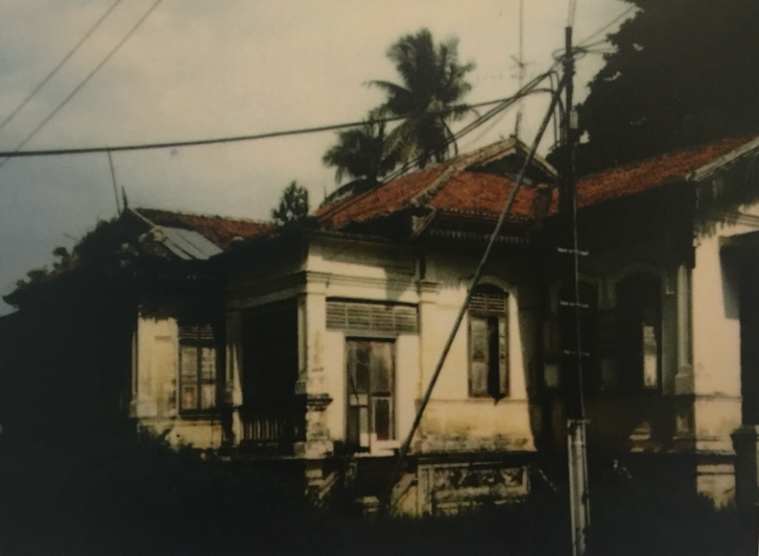 A photograph showing a “comfort station” in downtown Malacca, Malaysia, from an exhibit at ‘The House of Sharing’. (Photo credit: Hirofumi Hayashi/The House of Sharing/Express Photo: Neha Banka)
A photograph showing a “comfort station” in downtown Malacca, Malaysia, from an exhibit at ‘The House of Sharing’. (Photo credit: Hirofumi Hayashi/The House of Sharing/Express Photo: Neha Banka)
In 2015, South Korea under the Park Geun-hye government, came to an agreement to “settle” the long-standing issue of “comfort women”. Under the clauses of this agreement, Japan would give 1 billion yen to a fund for the “comfort women” to be administered by the South Korean government. Japan’s then prime minister Shinzo Abe had also issued an apology, accepting “deep responsibility” for the issue.
At that time, South Korea had said that under the clauses of the agreement, it would consider the matter resolved “finally and irreversibly” if Japan were to fulfill its promises. In addition, South Korea promised to look into removing a statue symbolising “comfort women”, which had been erected by activists outside the Japanese embassy in central Seoul in 2011. Both sides had also agreed to refrain from criticising each other in the international community on this issue.
 The statue symbolising “comfort women” erected outside the Japanese embassy in central Seoul, South Korea. (Express Photo: Neha Banka)
The statue symbolising “comfort women” erected outside the Japanese embassy in central Seoul, South Korea. (Express Photo: Neha Banka)
Following the signing of the agreement, former president Park Geun-hye faced fierce criticism in South Korea for accepting the clauses that many said were offensive, along with accusations from some lawmakers who called it a “traitorous” deal. This 2015 agreement still distresses Lee, who believes that the South Korean government unilaterally made decisions, prioritising its own interests, without consulting the surviving “comfort women” in the country. “It is not only the Japanese government, the Korean government is also responsible for this,” she says of the 2015 agreement.
“It was a deeply flawed agreement as what is essentially a matter of crime against humanity in principle (but without legal application to actions taken in the 1930s and 1940s) and must be remembered and discussed in perpetuity,” says Lee Sung-yoon, Kim Koo-Korea Foundation Professor in Korean Studies and Assistant Professor, The Fletcher School, Tufts University.
But this week’s ruling, he says, “is largely political— a stratagem for the South Korean government to score political points by appealing to ethnonationalism and a sense of justice.” Professor Lee believes that from a legal perspective, the ruling may just set a new precedent for a violation of international agreements and treaties. He points to the treaty of 1965 between Japan and South Korea that addressed the settlement of issues in regard to property, claims and aspects of what it termed “economic cooperation”. Through the terminology used in the treaty, Japan had made it clear that it was not offering reparations.
 Kang Il-chul describes her experiences in a “comfort station” in China where she was kept by the Japanese Imperial Army, during an interview in October 2019. (Express photo: Neha Banka)
Kang Il-chul describes her experiences in a “comfort station” in China where she was kept by the Japanese Imperial Army, during an interview in October 2019. (Express photo: Neha Banka)
According to clauses of this treaty, all issues between the two countries that were a result of Japan’s colonisation and the Second World War had “been settled finally and completely”. But eldery survivors of Japan’s wartime sexual slavery and forced labour have been pursuing independent claims through legal systems for years, often aided by rights groups. In 2017, survivors and the rights groups got an unexpected boost after South Korea’s President Moon Jae-in took office and openly expressed support for their endeavours.
In 2018, South Korea’s Supreme Court ruled in favour of South Koreans seeking compensation from Japan’s Nippon Steel & Sumitomo Metal over the issue of being subjected to forced labor during Japanese colonial rule. A few months after this ruling, in a separate lawsuit, the Supreme Court ordered Japan’s Mitsubishi Heavy Industries to compensate 10 South Korean nationals for being forced to build ships and aircraft for Japan’s war ambitions in 1944.
Japan rejected these rulings, issuing sharp criticism, because from Tokyo’s perspective, Professor Lee explains, it appears that these lawsuits filed against the Japanese government and organisations were construed as having violated “the norms of state sovereign immunity but also a breach of basic trust in the bilateral relationship”.
 Kang Il-chul walks back to her room inside ‘The House of Sharing’, in Gyeonggi province, South Korea, after an interview in October 2019. (Express photo: Neha Banka)
Kang Il-chul walks back to her room inside ‘The House of Sharing’, in Gyeonggi province, South Korea, after an interview in October 2019. (Express photo: Neha Banka)
During the 2018 ruling, South Korea’s Supreme Court had rejected the argument that the treaty of 1965 had put an end to the matter. “The treaty does not cover the right of the victims of forced labor to compensation for crimes against humanity committed by a Japanese company in direct connection with the Japanese government’s illegal colonial rule and war of aggression against the Korean Peninsula,” the court had said in a statement.
In a blog post in 2020 for ‘Origins’, published by the Ohio State University and Miami University, Professor Lee had argued that the South Korean Supreme Court’s argument was “weak” because “the 1965 treaty predates the establishment of the International Criminal Court (ICC) per the Rome Statute in 1998.”
“My point is that South Korea does not have jurisdiction over Japanese companies or the Japanese government for actions that happened before 1945,” he explains. “Ex post facto criminalization of the Japanese state’s offenses, as cathartic and just in principle as it may be, is a faulty legal argument. Imperialism and colonization are always exploitative. They are always cruel. But reconciliation and atonement must come from historical writing, public discourse, cultural contact, foreign aid, etc., not by formal government reparations.”
Following the Seoul court’s latest ruling, while in theory, the South Korean government could proceed and seize any Japanese property within its territorial jurisdiction, for instance, the Japanese embassy and the Japanese Cultural Center in Seoul and the Japanese consulate in Busan, Professor Lee believes that such moves “would amount to a salvo to breaking off the diplomatic relationship.” The impact would have wider implications for South Korean politics and economy and would be risks that the Moon administration may not be willing to take.
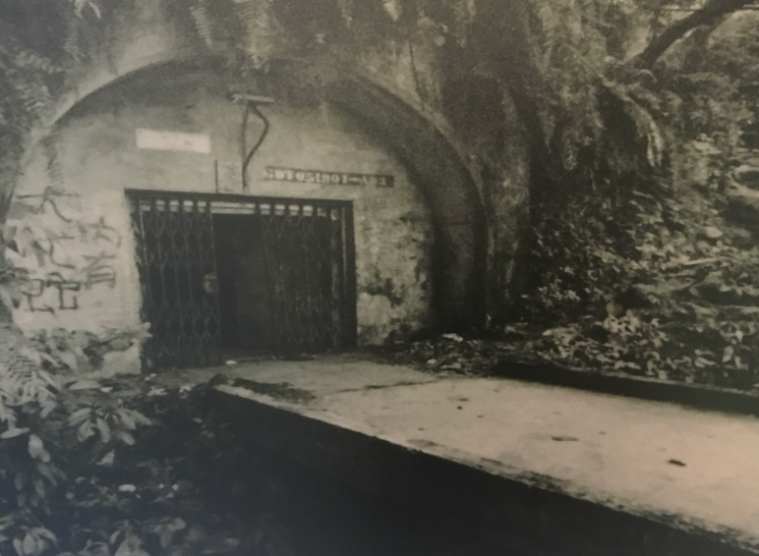 A photograph showing a structure used as a “comfort station” for coal miners in Chikuho, Kyushu, Japan, from an exhibit at ‘The House of Sharing’. (Photo credit: Rumiko Nishino/The House of Sharing/Express photo: Neha Banka)
A photograph showing a structure used as a “comfort station” for coal miners in Chikuho, Kyushu, Japan, from an exhibit at ‘The House of Sharing’. (Photo credit: Rumiko Nishino/The House of Sharing/Express photo: Neha Banka)
The legacy of Japanese colonisation is always in the background when it comes to geopolitics in East Asia, but especially in the case of South Korea and Japan, with both sides unvaryingly accusing the other of deliberate provocation. In 2013 when Shinzo Abe made visits to the Yasukuni shrine, a controversial war memorial which honours Japan’s war dead, but also 14 convicted war criminals, both China and South Korea issued strong objections. In 2020, days after Abe stepped down as prime minister, he made yet another public visit to the shrine, one that was sharply criticised by North Korea. Seoul, Beijing and Pyongyang have considered these visits by Japanese leaders a show of a lack of remorse for Japan’s colonial brutality and war crimes during the Second World War.
The fierce public backlash to the 2015 agreement also prevented the South Korean government from removing the bronze statue symbolising “comfort women”, which had been erected by activists outside the Japanese embassy in central Seoul in 2011. Every Wednesday since 1992, a small group of protestors gather outside the embassy, calling for accountability and justice, in what they call the ‘Wednesday Demonstrations’.
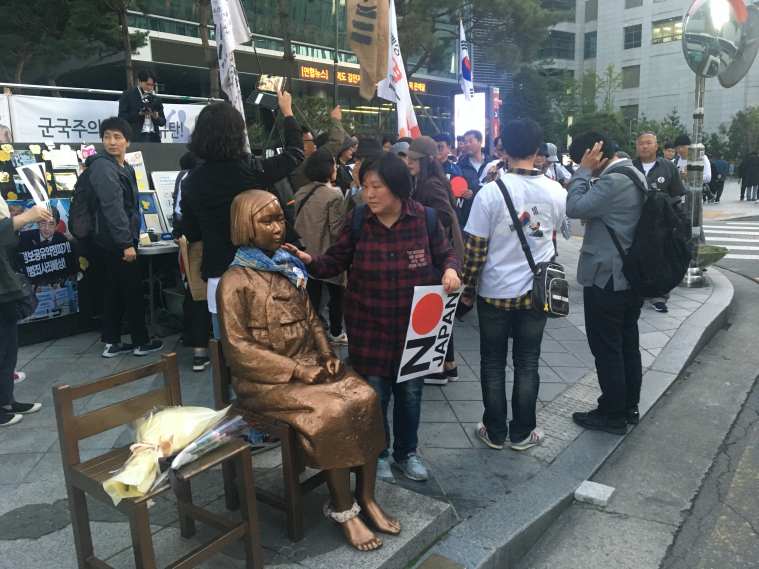 At a ‘Wednesday Demonstration’ taking place outside the Japanese embassy in central Seoul, South Korea, a protestor cleans the face of the statue symbolising “comfort women” in October 2019. (Express Photo: Neha Banka)
At a ‘Wednesday Demonstration’ taking place outside the Japanese embassy in central Seoul, South Korea, a protestor cleans the face of the statue symbolising “comfort women” in October 2019. (Express Photo: Neha Banka)
Two days after the 2015 agreement was signed, a group called the “Anti-Abe and Anti-Japan Joint Action” set up a small tent just beside the bronze statue, and has been sitting in permanent protest outside the Japanese embassy, with volunteers manning the tent round the clock, regardless of weather conditions. Protecting the embassy are several buses belonging to the city police and a dozen policemen on both sides of the street.
On a cold Autumn morning in Seoul, two 20-year-old women sit, huddled in long black puffy coats, with their tent having been unexpectedly taken down. The bronze statue nearby is wrapped in a thick red scarf, with a bunch of white flowers placed near its feet.
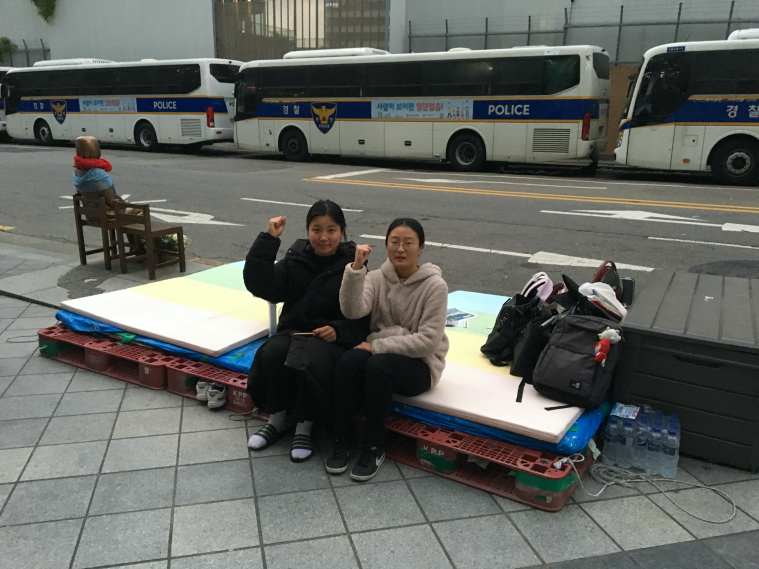 Two young women belonging to a group called “Anti-Abe and Anti-Japan Joint Action” sit in protest outside the Japanese embassy in central Seoul, South Korea in October 2019, after their tent was taken down by the local district office. (Express photo: Neha Banka)
Two young women belonging to a group called “Anti-Abe and Anti-Japan Joint Action” sit in protest outside the Japanese embassy in central Seoul, South Korea in October 2019, after their tent was taken down by the local district office. (Express photo: Neha Banka)
The tent is down, they explain, because they were forced to by the local Jongno District office, but the city government was unable to remove the women from the protest site. “We are fighting with the Japanese embassy. It’s difficult but we can do it. We see the embassy everyday,” says one of the women, both requesting anonymity.
The Seoul city government’s attempts to remove the protest site shouldn’t come as a surprise, Professor Lee says. “(President) Moon seeks to mend fences with Tokyo and use the Summer Olympics as a stage for a summit meeting with Kim Jong Un. While Kim is unlikely to show up in Tokyo as one among many, that has been the main incentive for Seoul’s de-escalation in recent months.”
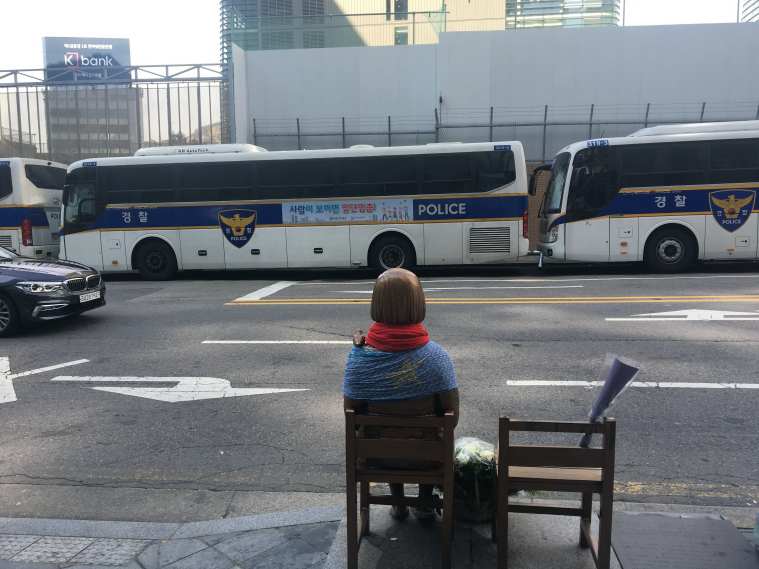 The statue symbolising “comfort women” sits facing the Japanese embassy in central Seoul. (Express photo: Neha Banka)
The statue symbolising “comfort women” sits facing the Japanese embassy in central Seoul. (Express photo: Neha Banka)
It is also complex domestic politics at play: “when anti-Japanese stance is prescribed, the lower officials follow. When the mood swings the other way, the lower officials are quick to catch on and discourage anti-Japanese protests by civic groups.” Following the coronavirus outbreak in 2020, the city government appears to have cleared the tent citing public health protocols, but the protestors have continued demonstrating at the site outside the embassy.
 A photograph showing the entrance to a “”comfort station” for the Japanese military in Nanking, China, from an exhibit at ‘The House of Sharing’. (Photo credit: Testuo Yamatani/The House of Sharing/Express photo: Neha Banka)
A photograph showing the entrance to a “”comfort station” for the Japanese military in Nanking, China, from an exhibit at ‘The House of Sharing’. (Photo credit: Testuo Yamatani/The House of Sharing/Express photo: Neha Banka)
Over the past two decades, Lee has travelled around the world, taking her story, to raise more awareness of the wartime sexual slavery and violence that she and countless other girls and women were subjected to. The museum at the ‘House of Sharing’ has extensive archives of photographs, recorded testimonies, manuscripts, etc. that document the war years and the women’s experiences.
Some survivors who had retained objects from their time in the Japanese military camps later donated them to the ‘House of Sharing’ and other similar institutions for research and archival purposes. When asked about whether she did something similar, Lee laughs: “No, I only have oral testimonies as evidence.” Suddenly, her voice cracks. “Of course it is very hard. It is still hard to make a testimony in public. Although so much time has passed, I was just a 15 year-old girl (then). I still feel pain when I remember that time.”
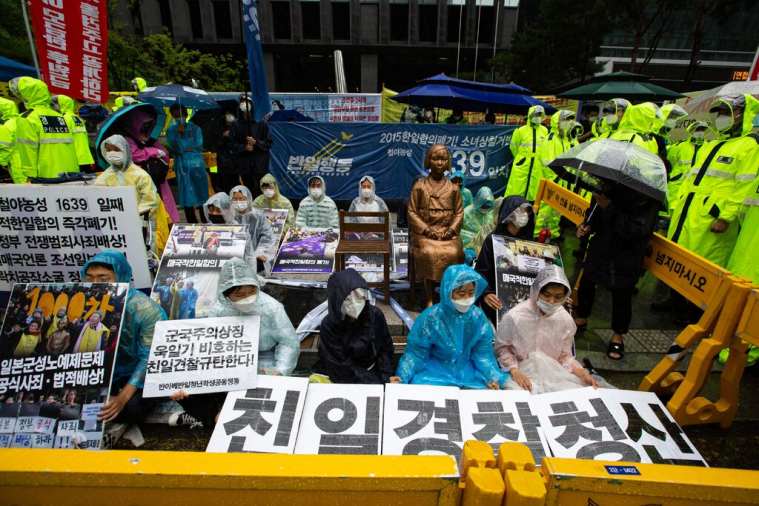 Demonstrators at a rally outside the Japanese Embassy in Seoul in June gathered around a statue symbolizing a woman forced into wartime sexual slavery. (Credit: Jeon Heon-Kyun/EPA, via Shutterstock/The New York Times)
Demonstrators at a rally outside the Japanese Embassy in Seoul in June gathered around a statue symbolizing a woman forced into wartime sexual slavery. (Credit: Jeon Heon-Kyun/EPA, via Shutterstock/The New York Times)
Staff members at the ‘House of Sharing’ have helped Lee keep track of Friday’s Supreme Court judgement and the subsequent developments. “I am not satisfied with the order unfortunately, because what we are demanding from Japan is not only compensation, but also an apology. Our fight for justice is not finished yet,” she says.
“Please help me get justice from Japan.”
(Editorial note: Interviews with survivors and protesters were conducted in Seoul and in Gyeonggi province, South Korea, in October 2019. Lee Ok-seon also provided a statement following the January 2021 court ruling.)
This article is auto-generated by Algorithm Source: indianexpress.com


